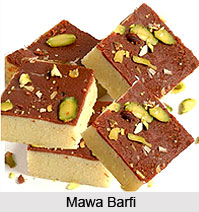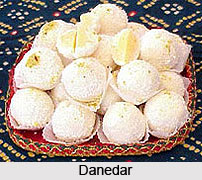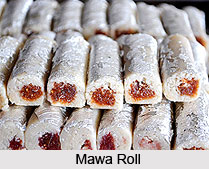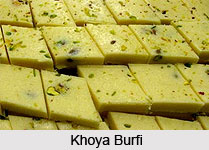 Khoya or mawa is a dairy product. Khoya is used in making many sweets dishes and gravy vegetables. It is considered as one of the important dairy products and in many houses it is very commonly used.
Khoya or mawa is a dairy product. Khoya is used in making many sweets dishes and gravy vegetables. It is considered as one of the important dairy products and in many houses it is very commonly used.
Khoya can be made at home, though the method is little tedious. It is prepared by boiling and reducing the milk to a semi-solid stage. There are different types of khoya depending on the use of ingredients and moisture content.
Batti ka khoya: This is solid and moulded khoya. It is made out of full cream buffalo milk. The milk is boiled in a large kadhai (big pan) on a high flame, and stirred occasionally. The flame is reduced when the milk thickens. When the mixture is in a semi-solid stage it is removed from the fire and set into moulds. A litre of milk will yield 200 gm of khoya. This khoya is used in burfies and laddus.
Daab ka (or chikna) khoya: This is made with low fat buffalo milk. The process of making it is the same as for batti ka khoya but it is removed from the fire slightly earlier. It is loose and sticky in consistency with a higher moisture content. It is suitable for making gulab-jamuns and gajar ka halwa..
Danedar (or granulated) khoya: This khoya is made out of full cream buffalo milk. The difference is that khoya is curdled slightly by adding little tartary in powder form. The milk curdles slightly hence the khoya is soft textured. Care should be taken not to spoil the texture while stirring. The water content is more than batti ka khoya but less than the chikna khoya. This type is used in making kalakand and laddu.
Some recipes of Khoya or Mava mithai are:
Sweet Kachori
Ingredients:
For filling:
200 gms. khoya
50 gms milk powder
1/2 tsp. nutmeg-cardamom-cinnamon powder

For cover:
250 gms. plain flour
1 tbsp. cornflour
30 gms. ghee
For syrup:
250 gms. sugar
1 cup water
1 big pinch saffron
Ghee for deep frying
Method: Mix ingredients for filling. The mixture should be soft and crumbly. Mix ingredients for cover. Using water knead to a pliable dough. Cover with a wet cloth. Keep aside. Boil sugar and water adding a tbsp. of milk to clear the syrup.
Boil till the syrup is slightly sticky between the fingers. Strain. Crush and add the saffron. Keep aside. Make 15 to 16 flattish balls of the mixture. Divide dough also into 15 to 16 parts. Roll one part into a puri, place one mixture ball in the centre.
Pull up all the sides to seal the mixture and press in centre. Make 5 to 6 such kachoris, heat ghee and fry on low flame till light brown, turning once. Repeat for remaining kachoris. When slightly cool, make a hole in the centre of each (approx. 2cm. diameter). Pour about half tbsp. of syrup and roll kachori around to let the syrup spread. Allow to stand for half hour before serving.
Mawa Roll
Ingredients
1 pouch Milk Powder
 1 can Condensed Milk
1 can Condensed Milk
1 Medium spoon Yogurt
1 Medium spoon unsalted Butter.
1 Packet Flour Bread
4 Spoon Milk
100 gms Almonds and Kaju
Silver Sheet for Decorating.
Method: In a small vessel boil water and add 100 gms of almonds peel the skin and cut into small pieces. In a heavy bottom microwave pan melt butter for a minute then add all the other ingredients listed above and stir briskly. Microwave for 10 mins (Stir in between) until you get slightly brown granules of mawa. Stir again and microwave for just 2 minutes. Remove and let it cool. Make tiny pieces of Kaju and peeled Almonds. Mix it with the mawa mixture and then make cylindrical rolls out of this mixture. Keep aside.
Take flour bread from cut the sides of the bread and then place it on a plate sprinkle few drops of milk and place the mawa mixture inside the soft bread. Roll the bread in such a manner that the mawa mixture inside should be intact. There should not be any holes while rolling the bread. Keep aside. In a vessel take 2 cups of sugar and 1 cup water let it boil till you get 1 thread consistency. Put off the flame and let it cool.
In a bottom pan heat ghee/oil and deep fry these cylindrical rolls and keep aside on a paper towel. Dip these cylindrical mawa rolls in sugar syrup and let it remain for 20 minutes. Check to see if the bread has soaked the syrup. Drain the rest of the syrup and decorate with silver sheets. Refrigerate.
 Khoya Burfi
Khoya Burfi
Ingredients:
1 can of Sweetened Condensed Milk
2 cans of Carnation Milk Powder
1 stick of Butter
1/2 cup of Mixed Nuts crushed (Pistachios, Almonds & Cashewnuts)
1 tsp of Cardamom Powder
Method: In the microwave place a corning ware dish with 1 stick of butter and melt it for 1 minute. Remove, then add all ingredients mix it to the melted butter. Keep it back in microwave for 5 minutes. Let it cool for a 1 or 2 minute then cut into pieces. Serve it warm.




















